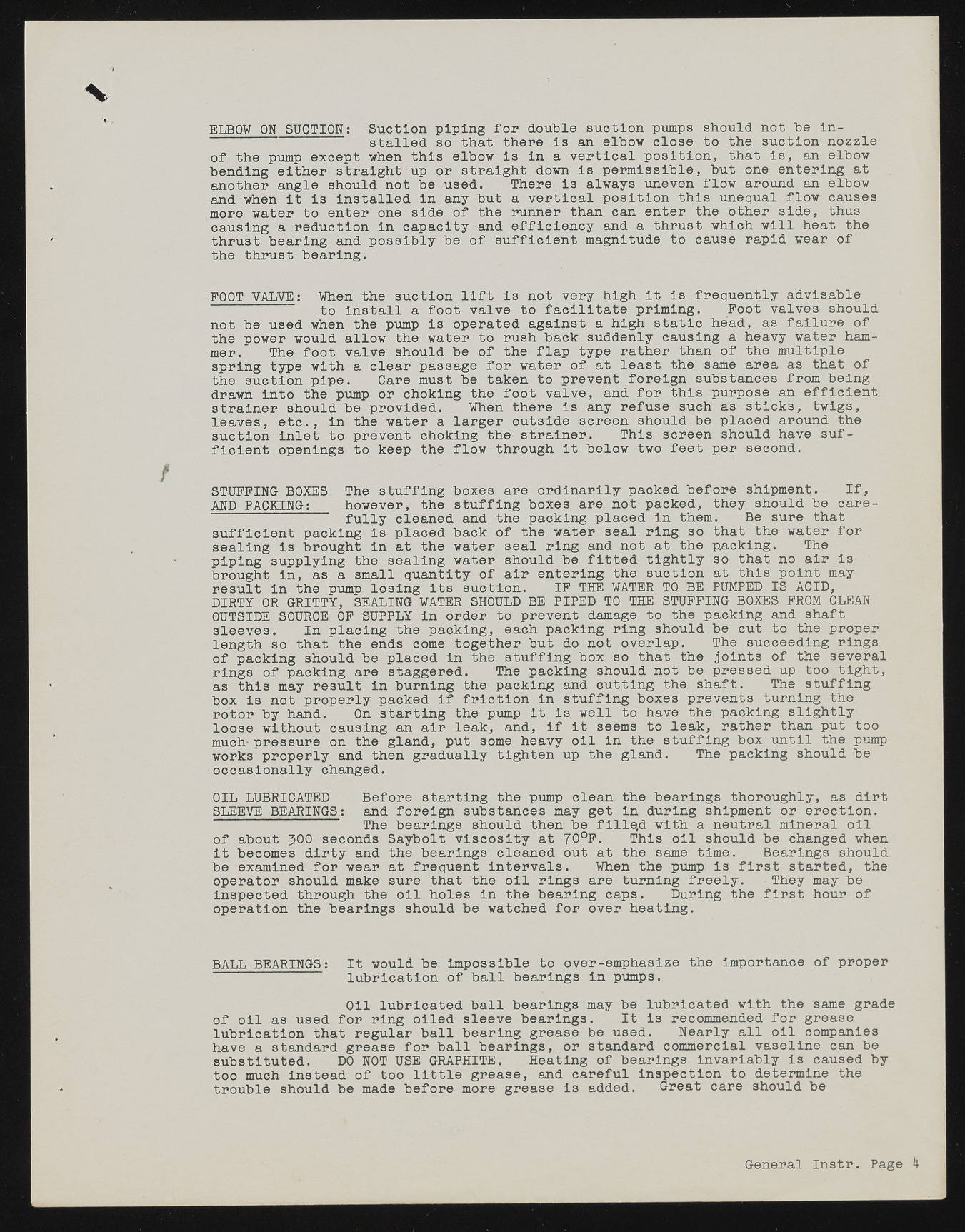Copyright & Fair-use Agreement
UNLV Special Collections provides copies of materials to facilitate private study, scholarship, or research. Material not in the public domain may be used according to fair use of copyrighted materials as defined by copyright law. Please cite us.
Please note that UNLV may not own the copyright to these materials and cannot provide permission to publish or distribute materials when UNLV is not the copyright holder. The user is solely responsible for determining the copyright status of materials and obtaining permission to use material from the copyright holder and for determining whether any permissions relating to any other rights are necessary for the intended use, and for obtaining all required permissions beyond that allowed by fair use.
Read more about our reproduction and use policy.
I agree.Information
Digital ID
Permalink
Details
More Info
Rights
Digital Provenance
Publisher
Transcription
\ ELBOW ON SUCTION: Suction piping for double suction pumps should not be installed so that there is an elbow close to the suction nozzle of the pump except when this elbow is in a vertical position, that is, an elbow bending either straight up or straight down is permissible, but one entering at another angle should not be used. There is always uneven flow around an elbow and when it is installed in any but a vertical position this unequal flow causes more water to enter one side of the runner than can enter the other side, thus causing a reduction in capacity and efficiency and a thrust which will heat the thrust bearing and possibly be of sufficient magnitude to cause rapid wear of the thrust bearing. FOOT VALVE: When the suction lift is not very high it is frequently advisable to Install a foot valve to facilitate priming. Foot valves should not be used when the pump is operated agaijist a high static head, as failure of the power would allow the water to rush back suddenly causing a heavy water hammer. The foot valve should be of the flap type rather than of the multiple spring type with a clear passage for water of at least the same area as that of the suction pipe. Care must be taken to prevent foreign substances from being drawn Into the pump or choking the foot valve, and for this purpose an efficient strainer should be provided. When there is any refuse such as sticks, twigs, leaves, etc., in the water a larger outside screen should be placed around the suction inlet to prevent choking the strainer. This screen should have sufficient openings to keep the flow through It below two feet per second. / STUFFING BOXES The stuffing boxes are ordinarily packed before shipment. If, AND PACKING: however, the stuffing boxes are not packed, they should be carefully cleaned and the packing placed in them. Be sure that sufficient packing is placed back of the water seal ring so that the water for sealing is brought in at the water seal ring and not at the p.acking. The piping supplying the sealing water should be fitted tightly so that no air is brought in, as a small quantity of air entering the suction at this point may result in the pump losing its suction. IF THE WATER TO BE PUMPED IS ACID, DIRTY OR GRITTY, SEALING WATER SHOULD BE PIPED TO THE STUFFING BOXES FROM CLEAN OUTSIDE SOURCE OF SUPPLY in order to prevent damage to the packing and shaft sleeves. In placing the packing, each packing ring should be cut to the proper length so that the ends come together but do not overlap. The succeeding rings of packing should be placed in the stuffing box so that the joints of the several rings of packing are staggered. The packing should not be pressed up too tight, as this may result in burning the packing and cutting the shaft. The stuffing box is not properly packed If friction in stuffing boxes prevents turning the rotor by hand. On starting the pump it is well to have the packing slightly loose without causing an air leak, and, if it seem3 to leak, rather than put too much- pressure on the gland, put some heavy oil In the stuffing box until the pump works properly and then gradually tighten up the gland. The packing should be occasionally changed. OIL LUBRICATED Before starting the pump clean the bearings thoroughly, as dirt SLEEVE BEARINGS: and foreign substances may get in during shipment or erection. The bearings should then be fille.d with a neutral mineral oil of about 300 seconds Saybolt viscosity at 70°F. This oil should be changed when It becomes dirty and the bearings cleaned out at the same time. Bearings should be examined for wear at frequent intervals. When the pump is first started, the operator should make sure that the oil rings are turning freely. They may be inspected through the oil holes in the bearing caps. During the first hour of operation the bearings should be watched for over heating. BALL BEARINGS: It would be impossible to over-emphasize the importance of proper lubrication of ball bearings in pumps. Oil lubricated ball bearings may be lubricated with the same grade of oil as used for ring oiled sleeve bearings. It Is recommended for grease lubrication that regular ball bearing grease be used. Nearly all oil companies have a standard grease for ball bearings, or standard commercial vaseline can be substituted. DO NOT USE GRAPHITE. Heating of bearings invariably is caused by too much instead of too little grease, and careful inspection to determine the trouble should be made before more grease is added. Great care should be General Instr. Page ^

